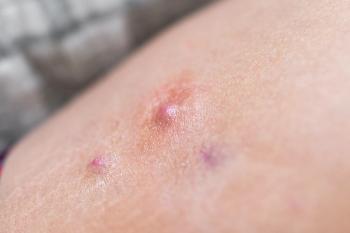
Dupixent Is Linked to a Higher Risk of Psoriasis in Patients With Atopic Dermatitis
AD and psoriasis were once thought to be opposites in terms of immune response, with AD linked to a Th2-dominant pathway and psoriasis driven by Th17 inflammation. However, newer research has shown that these diseases can overlap in patients and may even share common pathways.
Patients with atopic dermatitis (AD) who were treated with Dupixent (dupilumab) had a
Dupixent is a widely used biologic treatment for moderate to severe AD, a chronic skin condition caused by inflammation that shows up as red or discolored patches that are very itchy.
While Dupixent has been proven effective and generally safe, a number of reports suggest that it may increase the risk of developing psoriasis—a different inflammatory skin disease typically involving scaly plaques that often feels more like stinging or burning.
AD
AD and psoriasis were once thought to be opposites in terms of immune response, with AD linked to a Th2-dominant pathway and psoriasis driven by Th17 inflammation, according to study authors.
However, newer research has shown that these diseases can overlap in patients and may even share common pathways.
Blocking IL-4 and IL-13—the immune signals targeted by Dupixent—may unintentionally shift the immune balance toward Th17 activity, which is associated with psoriasis.
Some people receiving Dupixent for conditions such as asthma and alopecia areata have also developed psoriasis-like rashes, suggesting that the reaction may not be limited to those with AD.
In addition, joint pain resembling psoriatic arthritis has been reported.
While case reports have hinted at this connection for years, large-scale studies have been limited.
Researchers of the study conducted this retrospective cohort study to determine whether patients with AD treated with Dupixent had a higher risk of developing psoriasis compared to those receiving other treatments.
Deidentified health records from the TriNetX Global Network—which includes data from over 150 million patients across 17 countries—were used to identify eligible adults.
Participants were included if they had at least two AD diagnoses 30 days apart and initiated treatment with either Dupixent or another systemic therapy.
Patients with a history of psoriasis or prior use of similar biologics were excluded.
The study tracked new psoriasis diagnoses for up to three years, beginning one month after treatment started.
Researchers matched 9,860 Dupixent users to 9,860 control patients based on demographic and clinical factors to reduce bias.
They used several statistical methods to compare the groups, including ways to track how many people developed psoriasis over time and how significant the risk was.
Researchers also tested the results in different patient groups to make sure results were reliable.
In addition, a separate group of asthma patients without AD was studied to confirm the findings.
Results showed a 58% higher risk of psoriasis in the dupilumab group, though the absolute risk remained low.
Strengths & Limitations
This large study had several strengths, including the use of robust electronic health record data and a matched cohort design that reduced selection bias and allowed for a more accurate comparison between patients.
Researchers adjusted for factors including age, sex, race, comorbidities and lab results.
Multiple sensitivity and subgroup analyses, along with a validation study in patients with asthma, strengthened the reliability of the findings.
However, the study also had limitations.
Because the study was observational, it could not prove that Dupixent causes psoriasis.
The EHR data also lacked details on disease severity, treatment response and medication dosage or duration.
Some cases may have been misclassified due to limited diagnostic information, although efforts were made to reduce this risk.
The authors suggest that Dupixent could act as a trigger, rather than the sole cause, of psoriasis in those with certain immune profiles.
They recommend further research to better understand whether Dupixent also increases the risk of psoriatic arthritis and to explore differences among patient subgroups that may influence who is more vulnerable to these skin reactions.
Newsletter
Get the latest industry news, event updates, and more from Managed healthcare Executive.





















































